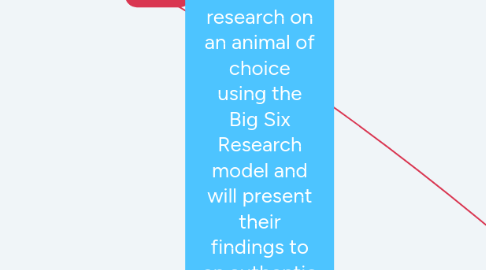
1. Learning Activities
1.1. requires
1.1.1. Defining the task
1.1.1.1. brainstorms
1.1.1.1.1. Prior knowledge of the an animal
1.1.1.1.2. Information they need to complete their understanding of the animal
1.1.1.1.3. Questions to drive research
1.2. plans
1.2.1. The Research Strategy
1.2.1.1. knows
1.2.1.1.1. How to locate library databases to use for research
1.2.1.1.2. How to use the online library catalog to search for animals
1.2.1.1.3. How to find animal websites for kids
1.3. locates
1.3.1. Relevant information on their animal
1.3.1.1. analyzes
1.3.1.1.1. Explore.org
1.3.1.1.2. Library databases
1.3.1.1.3. Nonfiction library books
1.4. uses
1.4.1. Research Information
1.4.1.1. to collaborate with
1.4.1.1.1. Animal-focused group
1.4.1.2. to organize thoughts into
1.4.1.2.1. Notes
1.4.1.2.2. Outline
1.5. synthesizes information into
1.5.1. Flipgrid presentation
1.6. evaluates
1.6.1. Peer Review
1.6.1.1. assess by giving
1.6.1.1.1. Constructive feedback
1.6.1.1.2. Positive feedback
1.6.2. Self Assess
1.6.2.1. analyzes
1.6.2.1.1. Their final Flipgrid presentation
1.6.2.1.2. Their research process
2. Teacher Roles
2.1. involes
2.1.1. Connecting and coordinating lessons and lesson materials with the Library Media Specialist
2.1.1.1. connects
2.1.1.1.1. Students
2.1.1.1.2. Teachers
2.1.2. creating
2.1.2.1. A Flipgrid for each animal group
2.1.2.1.1. Tigers
2.1.2.1.2. Lions
2.1.2.1.3. Pandas
2.1.2.1.4. Penguins
2.1.2.1.5. Bats
2.1.2.2. critical thinking, driven, calm classroom community
2.1.2.2.1. allows
2.1.2.3. creating animal groups based on students' interest of animals
2.1.2.3.1. based on
2.1.2.4. An assignment through Google Classroom
2.1.2.4.1. contains
2.1.2.5. Animal collections on EPIC
2.1.2.5.1. sent to
2.1.3. modeling
2.1.3.1. productive research
2.1.3.1.1. done through
2.1.3.2. respectful collaboration within animal groups
2.1.3.2.1. modeled by
2.1.3.3. transforming note-taking into a Filpgrid
2.1.3.3.1. modeled by
2.1.4. assessing students
2.1.4.1. through
2.1.4.1.1. rubric
2.1.5. monitoring
2.1.5.1. each group
2.1.5.1.1. with
2.1.5.2. individual progress
2.1.5.2.1. by
3. Learning Goals
3.1. Know/Understand
3.1.1. Writing Process Steps
3.1.1.1. Plan
3.1.1.1.1. Outline
3.1.1.1.2. Notes
3.1.1.2. Produce
3.1.1.2.1. Flipgrid Presentation
3.1.1.3. Assess
3.1.1.3.1. Peer Review and Assessment
3.1.2. Applying the Research Process
3.1.2.1. Including
3.1.2.1.1. locating information in reference texts and electronic resources,
3.1.2.1.2. taking simple notes in own words
3.1.2.1.3. presenting and evaluating the information in a report using previously established teacher/student criteria
3.2. Be able to
3.2.1. Use Flipgrid as a tool
3.2.1.1. to
3.2.1.1.1. Assess classmates work
3.2.1.1.2. Complete their own presentation
3.2.1.1.3. Participate in virtual class discussion
3.2.2. Read independently for multiple purposes over sustained periods of time
3.2.2.1. by
3.2.2.1.1. reading text that is developmentally appropriate
3.2.2.1.2. producing evidence of reading
3.2.3. Use tools, technology and research
3.2.3.1. to
3.2.3.1.1. produce and publish writing
3.2.3.1.2. Interact and collaborate with others
4. Learning Assessment
4.1. diagnoses through
4.1.1. Pre-assessment
4.1.1.1. observes
4.1.1.1.1. initial video
4.2. evaluates through
4.2.1. Formative Assessment
4.2.1.1. is ongoing
4.2.1.1.1. student notes
4.2.1.1.2. student work compared to classmates
4.2.1.1.3. feedback
4.2.2. Summative Assessment
4.2.2.1. Criterion-referenced
4.2.2.1.1. rubric
